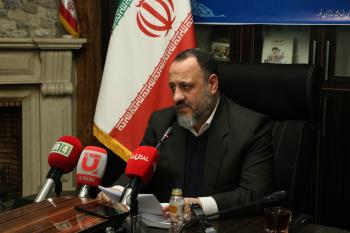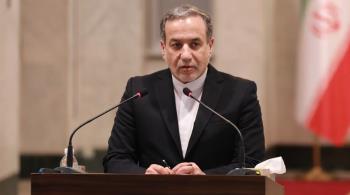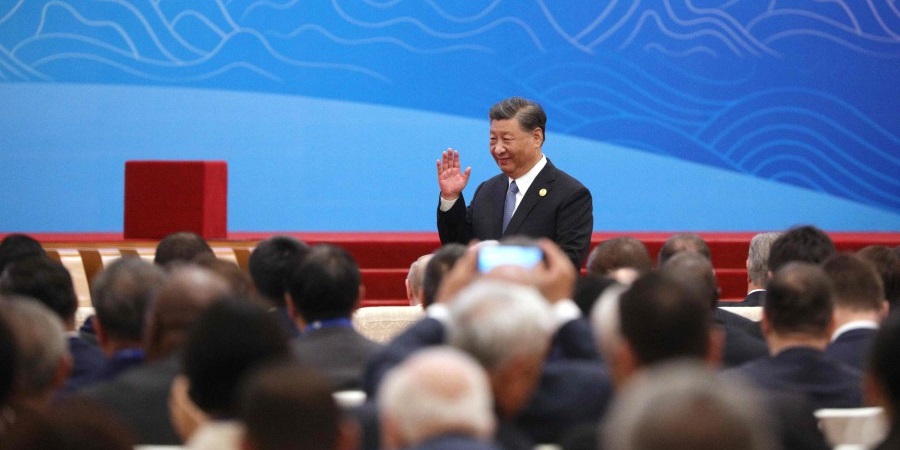Alwaght- While the Western countries are advancing a destabilizing project by inflaming crisis in Europe and West Asia, in another corner of the world, China is advancing a policy of political convergence and boost of international cooperation for collective growth by gathering together leaders of countries.
Putting the ambitious global Belt and Road Initiative (RBI) or New Silk Road project at the center of its foreign policy in recent years, China over the past days has been busy planning for the Third Road and Belt Forum for International Cooperation that was held on Tuesday and Wednesday.
The forum was initiated in 2013 by the Chinese leader Xi Jinping. This year’s forum theme was ‘high-quality Belt and Road Cooperation, Together for Common Development and Prosperity.’
President Jinping said at the opening of the forum on Tuesday that the Third Belt and Road Forum is “a glorious season in promoting a connected world and charting a path for all people individually and collectively.” He stressed that governments, businesses and individuals who are part of the RBI have made these achievements possible through their hard work, wisdom and courage.
“We must start a new journey towards another golden decade with motivation and enthusiasm,” he added, emphasizing the focus of this initiative on development, win-win game and inspiring results.
The Chinese Foreign Ministry had said that delegations from more than 140 countries and more than 30 international organizations will participate in this forum, and the number of registered participants exceeded 4,000 people. Russian President Vladimir Putin, Serbian President Aleksandar Vucic, Hungarian Prime Minister Viktor Orban, Vietnamese President Vo Van Thuong and others were country leaders who attended the meeting.
The two-day event hosted six seminars and three high-level forums on connectivity, green development and digital economy, and an entrepreneurs’ conference was also planned on the sidelines of the forum.
The first Belt and Road Forum for International Cooperation was held in May 2017 in Beijing. The presidents and prime ministers of 29 countries participated in it, and a total of more than 1,600 participants representing more than 140 countries and more than 80 international organizations attended it.
Next one was held two years later in 2019 and 38 country leaders attended it. The total number of participants was said to be 6,000 people.
Leaders from all over the world visited Beijing to participate in this forum, which is considered a turning point in advancing China’s position on the international stage given its important role at the political and economic levels.
RBI is an international initiative presented by China to improve and create new and existing trade and transport corridors. Its primary goal is to construct infrastructure and establish relations between Eurasian countries. The plan is multi-direction and covers ground and maritime trade. The initiative, known as the revival of the ancient Silk Road to strengthen global trade infrastructure, was launched by Xi in 2013 to connect China to Central Asia, West Asia, Europe, and Africa markets.
China’s global infrastructure investment
Over the past ten years, this project has grown from the planning to the implementation level and has become the largest platform for international cooperation. Given the fact that the railway infrastructures in developing countries are poor and investment in them is beyond the financial capacity of local governments, China has invested substantially to develop them.
Over the past 10 years, this initiative has attracted nearly $1 trillion in investments and more than 3,000 joint cooperation projects have been conducted. According to China’s Foreign Ministry, Chinese companies have created 420,000 jobs in countries along the RBI project. In total, more than 150 countries and more than 30 international organizations are somehow involved in the implementation of the Chinese plan. With these countries China has signed more than 200 cooperation agreements, which include 3,000 projects, according to the Russian news agency Sputnik.
“High-quality Belt and Road cooperation will bring more benefits to people and help empower global efforts to reduce poverty,” said Chinese Foreign Ministry Spokesman Mao Ning.
Mao said poverty eradication is the main goal of the 2030 vision for sustainable development, and over the past decade, the RBI’s agricultural cooperation mechanism has helped poor populations in countries participating in the initiative gain access to food and respond to food crises. Industrial investments and infrastructure projects under the RBI have provided a large number of job opportunities, he added.
The initiative was originally envisioned as a massive physical and digital infrastructure project to connect China with Central Asia, Southeast Asia, Europe and the rest of the world, and later became a massive infrastructure tool for Chinese lenders to support projects in other regions.
Dealing with the problems facing the project, Beijing is seeking to downsize the project and make it green and eco-friendly. It actually shifted from costly projects like dams and other infrastructural projects to high-tech projects like digital financial platforms and e-commerce. Analysts tell the Reuters the shift was aimed at helping push for a broader multipolar world system that gives more power to countries in the south, rather than the part of the world dominated by Washington and its allies.
In recent months, Beijing has tried to present itself as a member of the global south, despite the fact that as the world’s second largest economy, it only equals the US on the world stage.
The RBI has played a vital role in linking the world’s most urgent development needs to what China excels at, namely building roads and bridges to connect the world’s countries. President Jinping has a good understanding of the needs of developing countries and once said in an interview with the Wall Street Journal that from 2010 to 2020, the annual deficit in financing Asian infrastructure development reached about $800 billion. An Asian Development Bank report showed that developing Asia must invest $1.7 trillion annually in infrastructure until 2030 to maintain its growth momentum, and accordingly, the Chinese are trying to realize this aim through RBI by developing infrastructure in the countries along the Silk Road.
The Asian Infrastructure Investment Bank, the Silk Road Fund and other institutions have sponsored and invested in hundreds of projects, such as the China-Laos railway and the Jakarta-Bandung high-speed train, the first high-speed railway in the Southeast.
Deputy director of information at the Ministry of Foreign Affairs of China Wang Wanbin, said that the RBI is aimed at presenting a new ground for international economic cooperation and freshly accelerating the development of participating countries and global growth.
“A large number of transportation infrastructure projects greatly enhanced the development of Belt and Road Initiative partners, and clean, efficient and quality green energy projects paved the way for the future development of partner countries,” he said.
According to Xinhua news agency, China says that it had considered environment protection and improvement and protection of bio-diversity in implementation of the RBI and also signed over 50 documents to protect ecological environment with the related parties.
On the occasion of the Beijing forum, China released a new book in which the RBI considers development not only for China, but for the whole world. According to this book, a large number of infrastructure projects have been built with tangible progress for participating countries in the construction of railways and roads, highways, pipelines, shipping, energy, communications and other basic public service facilities. Along with the development of rail corridors, the maritime corridor continues to work as the second arm of the Chinese project, and according to reports, by June 2023, 117 ports in 43 countries have joined the project and more than 300 Chinese and international shipping companies have also joined the Maritime Silk Road Society.
Within the framework of the RBI construction, China has helped the participating countries build industrial parks and has instructed the Chinese companies to create job opportunities for local people through high-level industrial cooperation.
According to The Time, Chinese private sector is activated in an atmosphere once was under control of the policy-making of state banks and companies. This led to large-scale investment with a focus on world markets rather than building infrastructures. For example, Contemporary Ampwrex Technology CO. Limited (CATL) and Mercedes Benz AG intend to invest over $7 billion in a company in Hungary which is the biggest united project in a member of the BRI.
Linda Calabrese, a research fellow at the International Development Program at ODI tells The Time that the RBI funding is increasingly focused on small projects with specific objectives related to social issues. The shift is also driven by borrowers who are increasingly concerned about ending unmanageable debt or infrastructure projects, and this is a marked difference from when the RBI was unveiled in 2013.
The US forges rivalry for RBI
Although China over the past decade had done so much to conclude the project, Beijing leaders are even more determined to push forward with their project as the US is taking steps to contain its emerging rival China. Over the past year, when the level of tensions between Washington and Beijing escalated, Chinese leaders tried to block way of the American obstruction of their projects by including developing countries in their own initiatives. In recent months, the US, with the help of India and some Middle Eastern countries, proposed an alternative and parallel plan to the RBI, which is supposed to extend from India to Europe.
This initiative is in its infancy and no serious action has been taken in this direction, but Washington intends to complete this plan if the infrastructure and the participation of its allies in West Asia are ready. Americans believe that if the New Silk Road is built, which is connected to a network of railways in the world, China will take the pulse of world trade and the American hegemony will decline after a few decades, which is contrary to the interests of the West.
Therefore, China is trying to create a balance against the US by concluding the RBI. China’s initiative may have struggled in its first decade, but Beijing’s leaders still see it as an important tool for advancing China’s power and influence amid intensifying competition with Washington, and given the intensification of the competition between the two heavyweights, the RBI is expected to see a credibility boost for the Chinese leaders.
RBI prospects
The RBI, which is President Jinping’s vision for global growth, is one of the most accepted public projects on the world stage and grants opportunities for growth to many developing states. Therefore, the two-day meeting in Beijing provided a historic opportunity for all New Silk Road partners to build on the impressive achievements of this initiative and move towards deeper cooperation.
The RBI is a visionary plan at a global scale and brings peace, cooperation, development, and partnership to the world. It also reduces conflicts and encourages further popular appetite for increasing the trade, cultural, and tourist exchanges.
A Mckenzie Poll survey showed that the employment rate of local residents employed by Chinese companies active in Africa reached 89 percent, which effectively influences creation of job opportunities in these countries. The World Bank estimated that by 2030, Belt and Road investments could lift 7.6 million people out of extreme poverty and 32 million out of moderate poverty.
It is believed that the benefits of this plan will reach more parts of the world in the future. According to the World Bank, the RBI-driven trade boost is expected to increase the real global income to a range from 07 to 2.9. Another report by Center for Economics and Business Research (CEBR) suggests that it is estimated that the Chinese initiative is likely to boost the world GDP $7.1 trillion per annum by 2040.



























